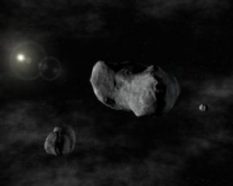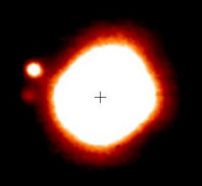Asteroid Moons
Astronomers have spotted an asteroid with two moons.
By Emily Sohn
Three’s company? In the realm of asteroids, that’s something new. For the first time, astronomers have found an asteroid with more than one moon.
 |
|
The asteroid 87 Sylvia and its two moons appear in this illustration, along with the sun (far left). |
| © European Southern Observatory |
The asteroid, called 87 Sylvia, is one of the largest in the asteroid belt, a collection of rocky objects that orbit the sun between Mars and Jupiter. The lumpy, potato-shaped asteroid is about 280 kilometers (174 miles) wide.
In 2001, astronomers announced finding a moon orbiting 87 Sylvia, making it one of about 60 asteroids known to have a moon. After the announcement of 87 Sylvia’s first moon, an astronomer from the University of California, Berkeley and several coworkers wanted to see if there were additional moons.
Asteroid moons probably form when large asteroids collide and break apart. Scientists have suspected that the process could end up leaving more than one moon around certain asteroids.
The astronomers looked through 2 months of images of 87 Sylvia. They spotted the second moon in images taken by an infrared camera on the European Southern Observatory’s Very Large Telescope in Chile.
 |
|
Telescope image of 87 Sylvia and the two moons. |
| Courtesy Franck Marchis/UC Berkeley and VLT |
The first moon measures about 18 kilometers (11 miles) across and orbits about 1,360 kilometers (845 miles) from 87 Sylvia. The newly discovered moon is smaller—about 7 kilometers (4.3 miles) across. It orbits 710 kilometers (441 miles) away.
By analyzing the orbits of 87 Sylvia’s moons, the astronomers were able to learn more about the asteroid itself. Like some other asteroids, it has lots of holes in it. Up to 60 percent of it, in fact, is empty space.
The asteroid and its moons appear to be the result of a collision between two large asteroids. Gravity keeps the lightweight objects loosely bound together. Astronomers call this kind of system a “rubble pile.”
Discovered in 1866, 87 Sylvia was named after Rhea Sylvia, a figure in Roman mythology. In the same spirit, the astronomers who discovered 87 Sylvia’s moons propose naming the moons Romulus and Remus, after Rhea’s two mythical sons who supposedly founded Rome.—E. Sohn
Going Deeper:
Cowen, Ron. 2005. Three’s company: Asteroid 87 Sylvia and her two moons. Science News 168(Aug. 13):101. Available at http://www.sciencenews.org/articles/20050813/fob5.asp .
You can learn more about asteroid 87 Sylvia and its two moons at www.eso.org/outreach/press-rel/pr-2005/pr-21-05.html (European Southern Observatory) and www.berkeley.edu/news/media/releases/2005/
08/10_sylvia.shtml (University of California, Berkeley).







